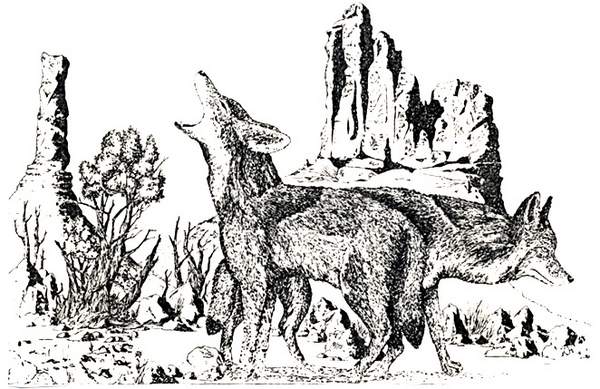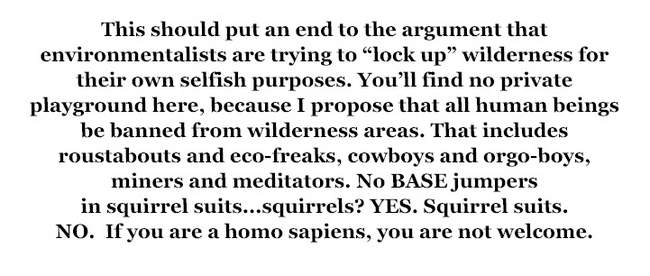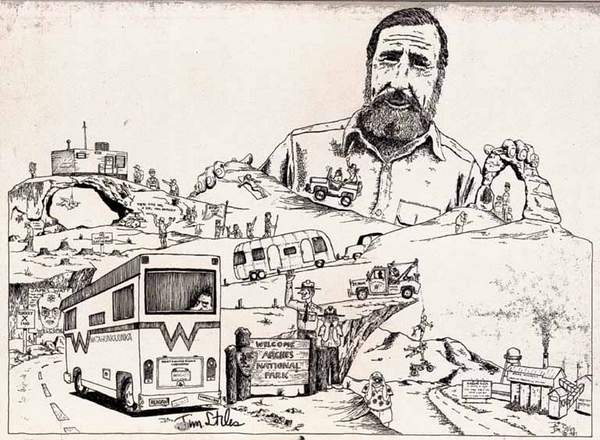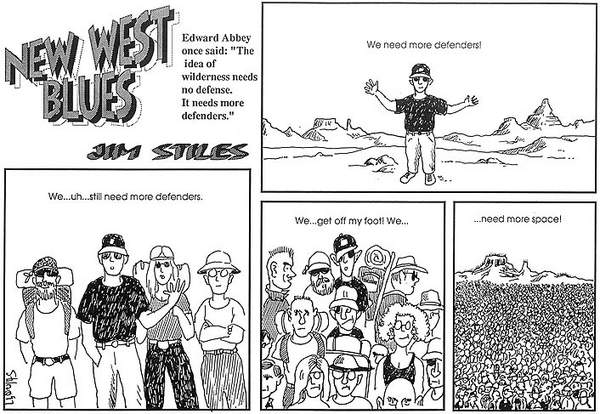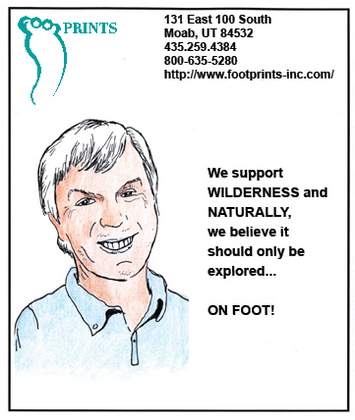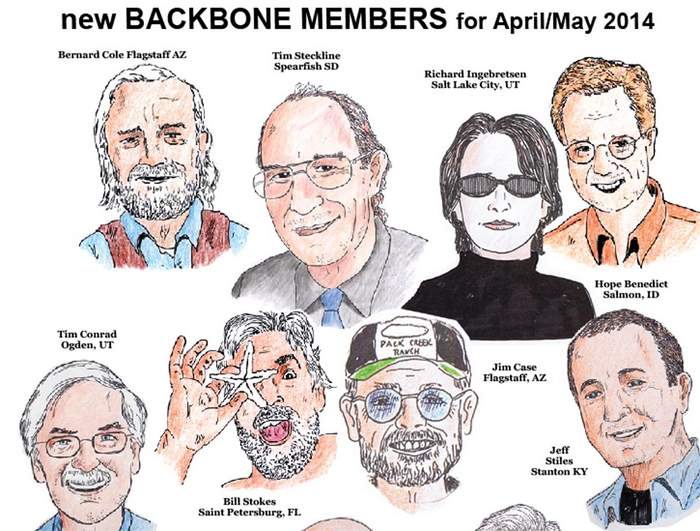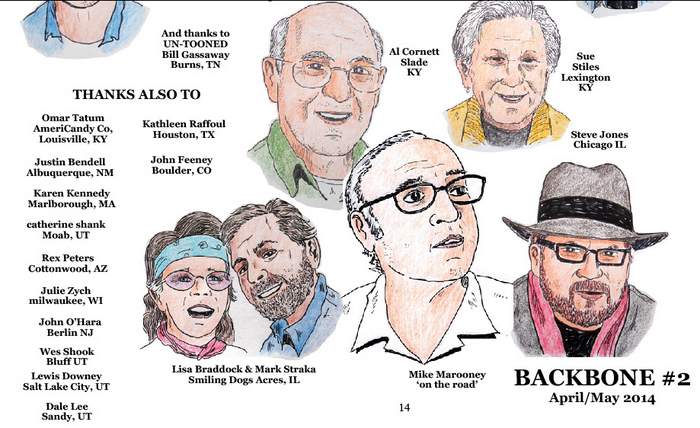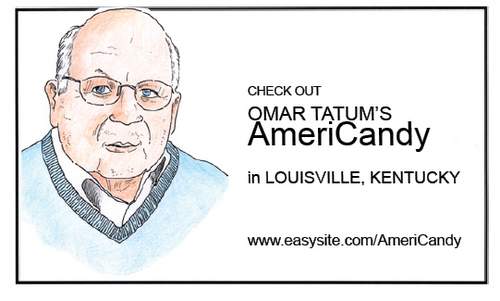Note: The original version of this story appeared in the June 1991 Zephyr.
For decades, since the Wilderness Act was passed by Congress in 1964, citizens of this nation have  waged war with each other over the need for wilderness and the size of the wilderness we need. The differences of opinion are staggering, the area of disagreement as wide as the Grand Canyon. Consider the views of Earth First! and the Western Association of Land Users (WALU.) The radical environmental group (so called) once proposed a 16,000,000 acre reserve for southern Utah which would turn our end of the state into one vast roadless area—Southern Utah before the uranium boom.
waged war with each other over the need for wilderness and the size of the wilderness we need. The differences of opinion are staggering, the area of disagreement as wide as the Grand Canyon. Consider the views of Earth First! and the Western Association of Land Users (WALU.) The radical environmental group (so called) once proposed a 16,000,000 acre reserve for southern Utah which would turn our end of the state into one vast roadless area—Southern Utah before the uranium boom.
WALU, the anti-wilderness/pro-
Pro- and anti-wilderness advocates cast a wary eye at each other. If you talk to pro-wilderness advocates, they’ll tell you that the people who oppose wilderness area bunch of ignorant, selfish greedheads who want to exploit, develop, mine, ranch, timber, and eventually ruin every square inch of wildlands left in this country. They have absolutely no appreciation for beauty—they wouldn’t recognize beauty if it fell on their heads. They have no vision, no sense of responsibility to the future, to our grandchildren. They’re slobs.
If you talk to an anti-wilderness advocate, he will tell you that people who support wilderness are a bunch of ignorant, selfish greedheads. All they want to do is “lock up” the wilderness for their own private playground. They say they oppose oil and gas development but all of them drive down here in gas guzzling cars and trucks. They say they care about the environment but they throw their garbage everywhere, and crap wherever they feel like crapping, and drive their bicycles where even motorbikes fear to tread. They’re slobs.
Both pro- and anti-wilderness advocates despise the BLM.
In the end, it is the accusation of greed and selfishness that both groups fling at the other with such self-righteous passion. Self-interest is the prime motivator, as viewed across the trenches by both camps.
What are we to do? What is the answer? How do we untangle the two sides so we can move ahead and resolve this issue, once and for all? I have studied the wilderness debate for decades now, ever since I moved to Moab and discovered that Ed Abbey’s views on nature were not shared by a majority of Grand County’s population. Many years have passed since an angry mob of Moabites followed a flag-draped bulldozer up a canyon and defiantly punched a hole in a wilderness study area. And now, in the second decade of the 21st century, we are seemingly no closer to a resolution.
But at long last, I believe I have developed a series of proposals which should stop all the fussing. They eliminate the greedy, self-interest angle. They eliminate the double standard. They are remarkable in their simplicity.
I am pleased to present “The Canyon Country Zephyr Wilderness Alternative,” first presented in this publication in 1991, almost totally ignored by the special interests on each end of the squabbling spectrum, and offered yet again for your consideration…
Alternative #1 EVERYBODY OUT (NO COMPROMISE)
This should put an end to the argument that environmentalists are trying to “lock up” wilderness for their own selfish purposes. You’ll find no private playground here, because I propose that all human beings be banned from wilderness areas. That includes roustabouts and eco-freaks, cowboys and orgo-boys, miners and meditators. No BASE jumpers in squirrel suits…squirrels? YES. Squirrel suits. NO. If you are a homo sapiens, you are not welcome.
We keep saying that we want to preserve the last remnants of the primal Earth, the land that lay untouched before human hands fell upon it. To accomplish that goal, and to show that our motives are pure, we must all make a sacrifice. Aldo Leopold once said, “To what avail are forty freedoms without a blank spot on the map?” We must set out to turn these wilderness areas into “blank spots.” To steal an idea from that Earth First! wildman and fire-brand preacher Dave Foreman, our first step should be to eliminate wilderness areas from all maps, guidebooks, brochures, handbooks, and government reports.
Descriptions of trail routes, features and springs, warnings of hazardous terrain and poisonous snakes should be obliterated. Even topographic maps should delete all information, even elevation lines. Remember the first incomplete maps by early explorers? They were liberally sprinkled with two words that sound like music to my large-lobed ears–“Unknown Territory.”)
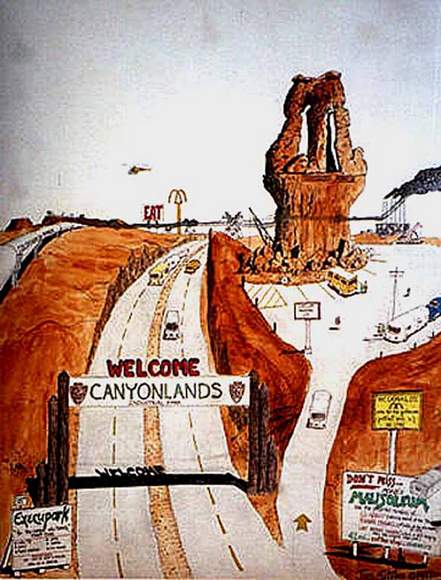 And while it’s easy for me to proclaim that all of the prolific Michael Kelsey’s guide books should be withdrawn from bookshelves, it is painful, but necessary, to insist that all photographs of wilderness areas be withdrawn as well. That includes the great works of Phillip Hyde, Eliot Porter, and Tom Till. (Thank God Till pre-paid for this month’s ad.)
And while it’s easy for me to proclaim that all of the prolific Michael Kelsey’s guide books should be withdrawn from bookshelves, it is painful, but necessary, to insist that all photographs of wilderness areas be withdrawn as well. That includes the great works of Phillip Hyde, Eliot Porter, and Tom Till. (Thank God Till pre-paid for this month’s ad.)
The temptation to illegally enter these wilderness areas will be great. Too great for some to withstand. Obviously, some type of enforcement will be necessary to ensure human-free wilderness. But the last thing we need is a bunch of government weenies, in polyester uniforms, packing over-sized firearms, and roaming the perimeters in search of violators, so they can write a ticket. And now, even drone patrols in search of malefactors is feasible. This cannot be allowed to happen either.
In fact, these new wilderness areas should be taken out of the jurisdiction of the Bureau of Land Management, U.S. Government altogether.
In its place, I propose a citizens’ council, composed of different segments of the population. Since we’ve greatly simplified the rules and regs, i.e. no humans, period, there shouldn’t be much disagreement. To enforce the one rule in effect, I’d like to see a joint team of googly-eyed butterfly chasers and redneck mofos to team up, work side by side, and patrol the boundaries, making sure all the critters are left in place and arrogant interlopers driven from the wilderness edge..
Still, the idea of sneaking past the guards may be irresistible to an adventuresome few. I can understand the attraction myself. And so, to those who actually succeed, they deserve to be rewarded, not punished. I would like to suggest that anyone who can penetrate the perimeter of a wilderness area without getting caught be allowed to return there for no less than one month. But only by the terms and conditions set down in Alternative #2…
ALTERNATIVE #2…BAREFOOT IN THE PARK (COMPROMISE #1)
OK. Perhaps I’m being too misanthropic. As Bukowski once said, “It’s not that I hate people. It’s just that I feel a lot better when they’re not around.” Perhaps it’s an unworkable idea. So consider this possibility.
Wannabe wilderness explorers arrive at one of the several designated points of entry into a wilderness 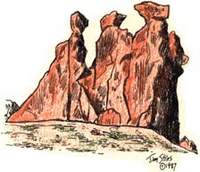 area. A member of the citizens’ council, assigned to this checkpoint, explains the wilderness concept. You must accept nature on its terms, not yours. To be a part of nature, you must assimilate with nature. You must be like the bird, the bear, the whiptail lizard. You must breathe freely and uninhibited through each and every pore of your body, in absolute harmony with the natural world.
area. A member of the citizens’ council, assigned to this checkpoint, explains the wilderness concept. You must accept nature on its terms, not yours. To be a part of nature, you must assimilate with nature. You must be like the bird, the bear, the whiptail lizard. You must breathe freely and uninhibited through each and every pore of your body, in absolute harmony with the natural world.
You must be naked. That’s right. Strip off the camera and binoculars. Unbutton that shirt. Unzip your trousers. Remove those stylish lavender briefs. Unsnap that sport bra. Bare your chest and bare your soul. Hidden splendors await you. Why not reveal your own?
You will have no use for Patagonia in a wilderness area. You can leave your JanSport pack at home. We came into this world naked, and we can go into wilderness areas the same way. However, once inside the wilderness, all restrictions cease. You have entered the primal world as a primal man and you are allowed to do whatever is required to survive. If you can “grin a bear to death” as Davy Crockett is reported to have done, more power to you. There are no bear seasons in the wilderness.
Within these wild places, Man and Woman will re-discover the skills, the talents, the link to the land that we lost so long ago. We will find them or we will perish, for there are no search and rescue teams in wilderness areas, no helicopter LifeFlights. The Grand County Search & Rescue Team can rest easy—this is out of their jurisdiction.
There are those among you who will believe this alternative is grossly unfair. Some will argue that it favors the exhibitionist types who like to run around naked, who are always the first ones to strip bare at a hot tub party.
I have considered this argument carefully and decided it has its merits. Being somewhat modest myself, I believe it is necessary to deal directly with the problem. Therefore, I propose that a catalpa tree be planted at each wilderness area point of entry. The catalpa leaf is very large and very durable. Several well-placed leaves should cover every part that anyone might want to conceal, and allow the shyest of of the shy to walk freely.
ALTERNATIVE #3…FALLOW WILDERNESS (COMPROMISE #2)
Farmers long ago discovered the value of letting cultivated fields lay fallow for a period of time. They learned that when they planted crops year after year on the same piece of ground, they sucked the nutrients right out of the soil and eventually left it barren and unproductive. They good earth needed a rest, a chance to recover and recuperate.
The same can be said of wilderness. How many years have passed since it was first suggested that, by our sheer numbers, we were loving our favorite wild places to death? This alternative suggests a compromise of the first two options set forth in this essay.
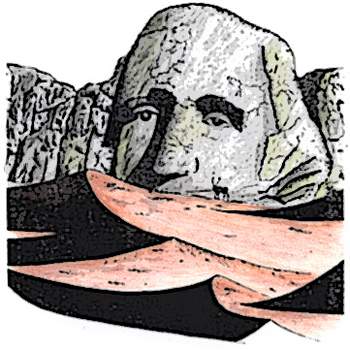 Instead of banning all humans for all time, let’s open them up for periods of a few years, and then close them for awhile. Let the rocks and trees and critters take a breather. We’ll set up the openings and closures of the different areas on a rotation basis. But, if the rush to any one wilderness reserve becomes excessive, the EARTH FIRST!/WALU Team will be on hand to control the crowd and boot them out if necessary.
Instead of banning all humans for all time, let’s open them up for periods of a few years, and then close them for awhile. Let the rocks and trees and critters take a breather. We’ll set up the openings and closures of the different areas on a rotation basis. But, if the rush to any one wilderness reserve becomes excessive, the EARTH FIRST!/WALU Team will be on hand to control the crowd and boot them out if necessary.
As for the “wilderness in the buff” proposal, we can perhaps modify that idea to allow clothing that was made by hand from natural fabrics, (please, no synthetics.)
One thing you will not see in these proposals is any claim of “economic benefit.” I’m not particularly interested in economic benefits when it comes to wilderness. Neither was the United States Congress when they passed the Wilderness Act. Some environmental groups have claimed that wilderness designation will be a great boon to the fortunes of nearby communities. That’s a pretty lame reason.
Wilderness, if we can get past the rhetoric, both for and against, is a very simple pure idea. It is a savings account for the future. But not OUR future…for ITS future. For no better reason than it is the right thing to do. That some places on this ever-shrinking planet deserve to be left alone. How many of us wish we could return to the homes we grew up in, and could find them just we way we left them? The same yard, the same trees, the same forsythia bush by the fence. Even if we couldn’t enter the yard or go inside? They would be like old friends that never change.
To me, that’s what wilderness is all about.
Jim Stiles is Founder and Co-Publisher of the Canyon Country Zephyr.
To read the PDF version of this article, click here.
Don’t forget the Zephyr ads! All links are hot!

